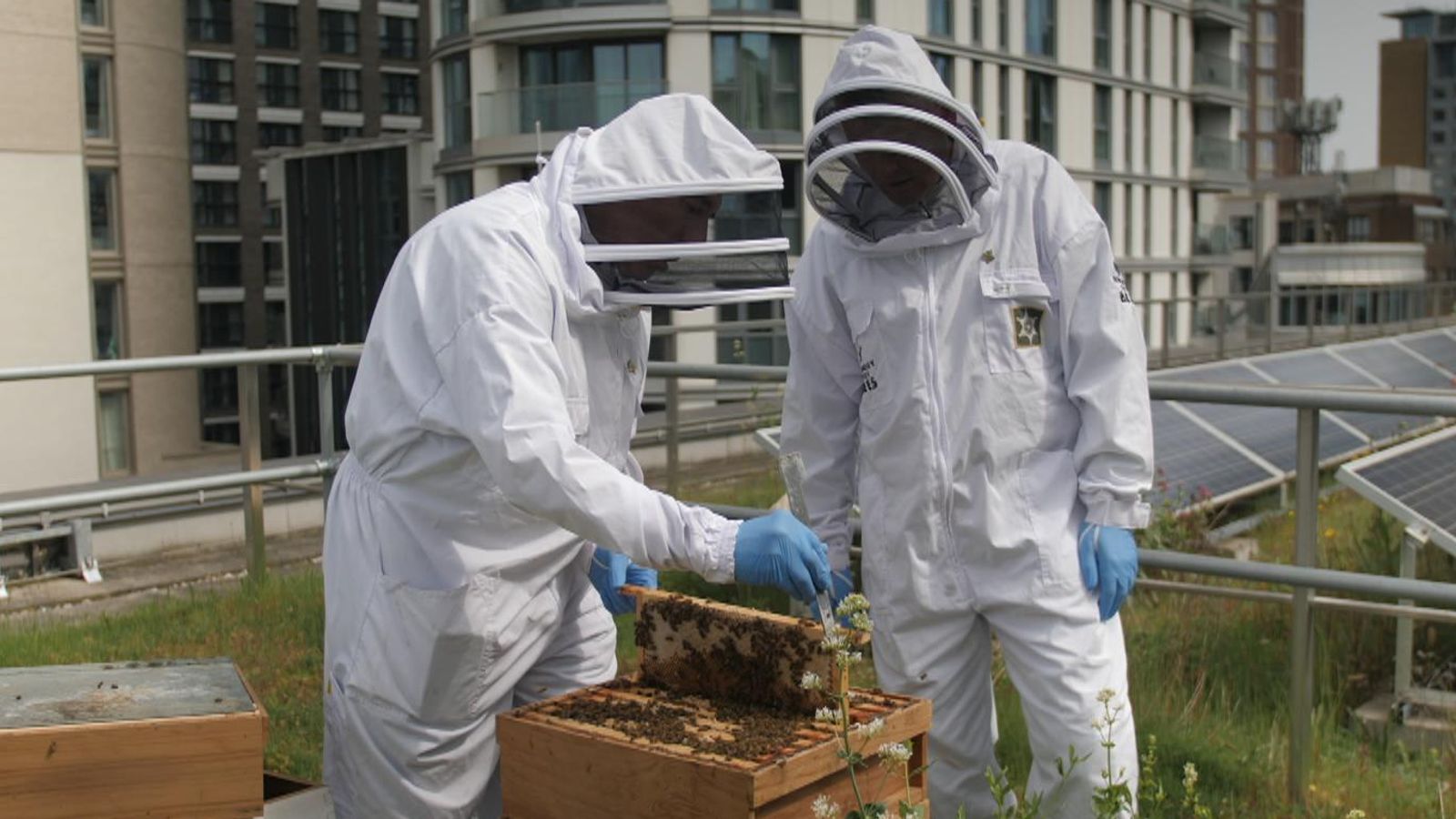We’ve been doing our best to save the honeybees – but now there’s a sting in the tail

I’m surrounded by towering glazed walls, concrete pillars and galvanised girders, the intrusive throb of helicopters and rising wail of police sirens.
It’s morning on a City of London rooftop. But that rooftop itself is a little oasis: a tennis court-sized patch of meadow complete with clover, buttercups and five beehives.
But only one is buzzing.
The remaining four are empty as the keeper, Dale Gibson of Bermondsey Street Bees, realised such numbers of honeybees were doing more harm than good.
“London is Europe’s most densely populated city for honeybees, possibly the world,” he said.
“We’ve been hijacked by the Save the Bees motto, which has been interpreted as meaning honeybees.
“Well, guess what? The honeybee is in great fettle.
“The UN hive data for honeybees globally shows they’re at an all-time high.
“What we need to do is see the impact these honeybees, with their proliferation, especially in places like London, is having on other pollinators and in particular other wild bees.”
Advertisement
Why the buzz around honeybees has changed
As today is World Bee Day, it’s a chance to ask how we got here when, just a few years ago, the buzz around bees was deafening – a theme of peril for honeybees that stretched from newspaper headlines to cultural norms, with Hollywood’s animated Bee Movie and plot lines in Doctor Who.
Professor Phil Stevenson works at the Kew Royal Botanical Gardens and has studied the bee craze.
“It’s probably because the narrative around saving bees came at the same time as issues around colony collapse disorder in the US, when whole hives died out,” he said.
“The problem is the density of hives.
“Our work suggested about seven hives per square kilometre was about as much as London could tolerate.
“In some locations in London there are more than 50 hives per square kilometre and in one particular location there are 400 hives in a square kilometre, and they all need feeding.”
The science may have moved on, but in the wider public, the love for honeybees is remarkably sticky.
This may seem a random observation, but when I was talking to a Sky News engineer while making this report, he showed me his phone: the case covered by a Save the Bees sticker with a honeycomb motif.
Hogging all the pollination
Pollination is the act of taking pollen between the male and female parts of different flowers, allowing seeds to form.
It is essential to the reproduction of our floral ecosystem, and much of our food relies on it, too.
But oil crops like rapeseed and soy, and fruits like strawberries and apples, are highly dependent on the labour of a whole range of insects – not just bees.
There are hundreds of other pollinating bee species and hundreds more wasps, flies, beetles, butterflies and moths which all need pollen and nectar.
Phil Stevenson has a favourite – the furry footed bee – and we also spot a chafer beetle with a glorious golden sheen enjoying a pollen binge.
A healthy ecosystem needs abundance and variety of pollinator species.
“There is absolutely concrete evidence you can see a halo around honeybee hives, not just in cities but also in wild landscapes, where you have a significant reduction in nectar and pollen and therefore a significant reduction in wild bees and solitary bees,” he said.
More climate news:
Global temperature ‘will likely break key limit’
Syrian president invited to COP28 climate summit
Honeybees’ sting in the tail
So, this isn’t just an urban or London problem.
Dr Lucy Witter is an entomologist and farm wildlife advisor working with the Cheshire Wildlife Trust.
“One of my biggest bugbears is people getting honeybees to help pollinators generally,” she said.
“It’s the equivalent of saying ‘we need to save wild birds, so let’s get some chickens’.
“Honeybees are a domesticated species”.
Click to subscribe to ClimateCast with Tom Heap wherever you get your podcasts
Dr Witter is not anti-honeybees if there is a guaranteed abundance of food, but, in many cases, they reduce the food available to native wild pollinators.
She also thinks their amazing PR detracts awareness from all those other critical pollinating insects – and as they are such efficient gatherers of pollen, they are worse at helping plants to reproduce.
“Honeybees don’t drop much pollen whereas solitary bees, like the red mason bee, are such messy eaters they end up covered in pollen and this falls off on other plants doing the pollination job,” she added.
So, as our well-intentioned passion for honeybees has ended up with a sting in the tail, what should we do?
Everyone we have spoken to agrees: provide habitat.
Whether it’s planting pollinator friendly plots or just letting flowering weeds flourish, give food and shelter to insects.
Phil Stevenson said: “What we really need to be doing is much more about the landscape itself, increasing the floral resources where wild bee species can nest and have refuge.”
Watch The Climate Show with Tom Heap on Saturday and Sunday at 3pm and 7.30pm on Sky News, on the Sky News website and app, and on YouTube and Twitter.
The show investigates how global warming is changing our landscape and highlights solutions to the crisis.

